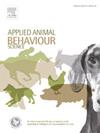Shelter or complexity? Nile tilapia (Oreochromis niloticus) preference for enrichment structures is a matter of time and frequency of visits.
IF 2.2
2区 农林科学
Q1 AGRICULTURE, DAIRY & ANIMAL SCIENCE
引用次数: 0
Abstract
Assessing fish preferences for resources may be an interesting approach to select environmental enrichments to improve their welfare. However, different operational variables may end up indicating distinct preferences. Here we investigated whether Nile tilapia (Oreochromis niloticus) express different preferences for environmental enrichment structures providing shelter and complexity by analyzing such responses based on time spent or frequency of visits as operational variables. We performed repeated choice tests with a clay pot providing single “shelter” and a suspended “complex” structure of intertwined ropes to infer the preferences of each individual (n = 44). Considering the frequency of visits in the enrichments, a similar number of fish preferred “shelter” or “complexity”, and there was no difference for the intensity of these responses. However, for the time spent at the enrichments, “shelter” was more intensely preferred. Moreover, there were individuals expressing opposite preferences depending on the operational variable, and most of them preferred “shelter” by time spent in it. In conclusion, Nile tilapia usually prefers to visit “shelter” and “complexity” similarly, but staying longer at the “shelter”. Thus, the frequency of visits to a resource or the time spent at one place, variables commonly used to infer animals’ preferences, can reflect different outcomes.
求助全文
约1分钟内获得全文
求助全文
来源期刊

Applied Animal Behaviour Science
农林科学-行为科学
CiteScore
4.40
自引率
21.70%
发文量
191
审稿时长
18.1 weeks
期刊介绍:
This journal publishes relevant information on the behaviour of domesticated and utilized animals.
Topics covered include:
-Behaviour of farm, zoo and laboratory animals in relation to animal management and welfare
-Behaviour of companion animals in relation to behavioural problems, for example, in relation to the training of dogs for different purposes, in relation to behavioural problems
-Studies of the behaviour of wild animals when these studies are relevant from an applied perspective, for example in relation to wildlife management, pest management or nature conservation
-Methodological studies within relevant fields
The principal subjects are farm, companion and laboratory animals, including, of course, poultry. The journal also deals with the following animal subjects:
-Those involved in any farming system, e.g. deer, rabbits and fur-bearing animals
-Those in ANY form of confinement, e.g. zoos, safari parks and other forms of display
-Feral animals, and any animal species which impinge on farming operations, e.g. as causes of loss or damage
-Species used for hunting, recreation etc. may also be considered as acceptable subjects in some instances
-Laboratory animals, if the material relates to their behavioural requirements
 求助内容:
求助内容: 应助结果提醒方式:
应助结果提醒方式:


